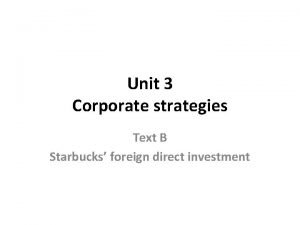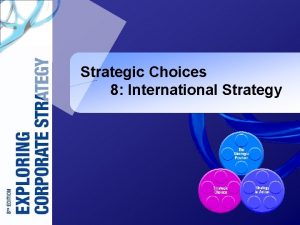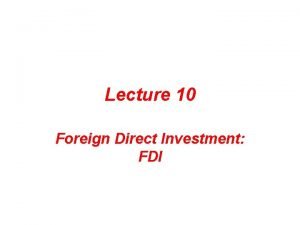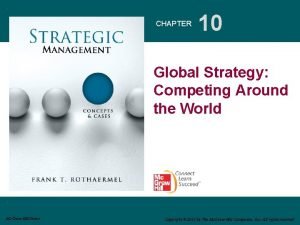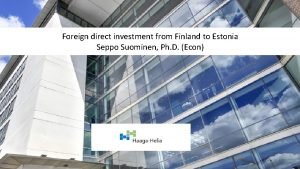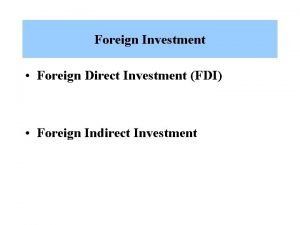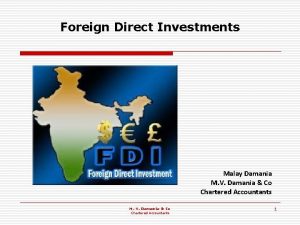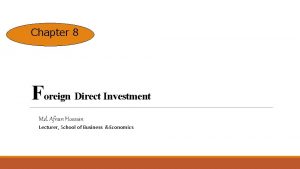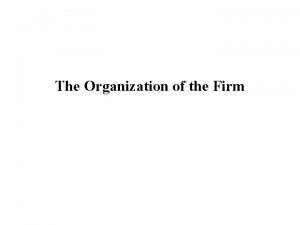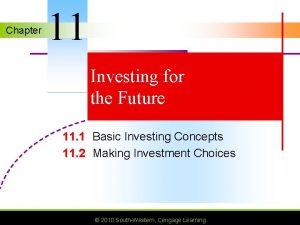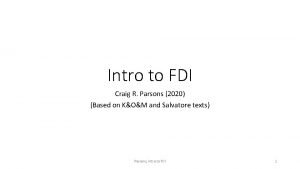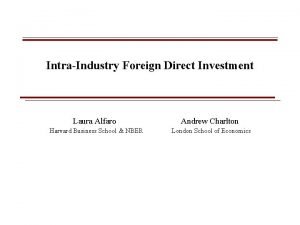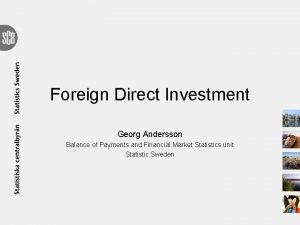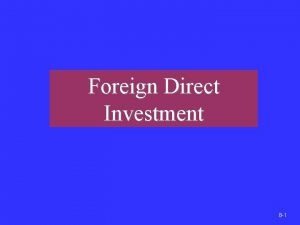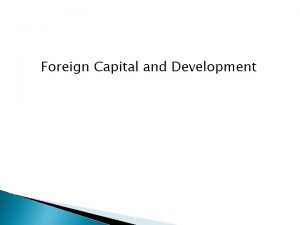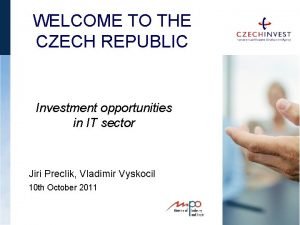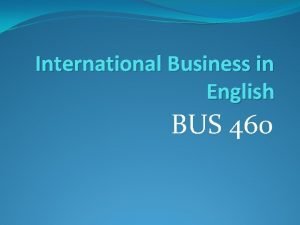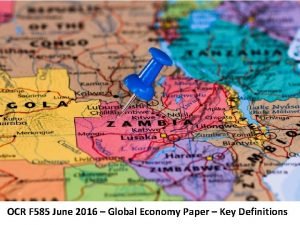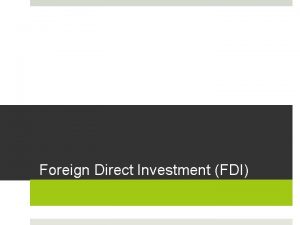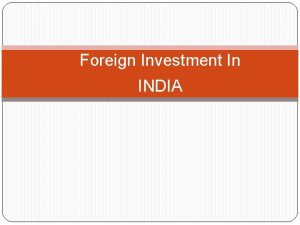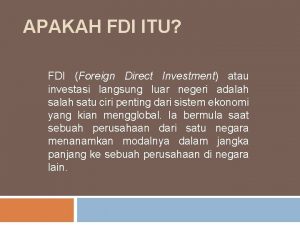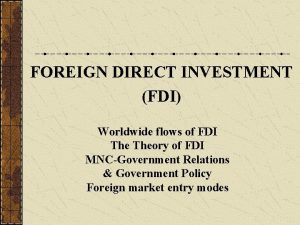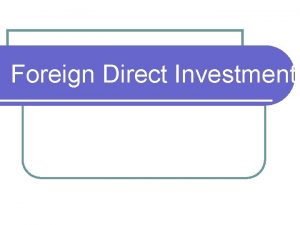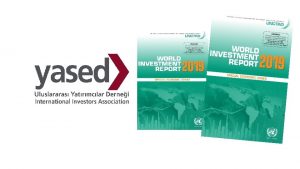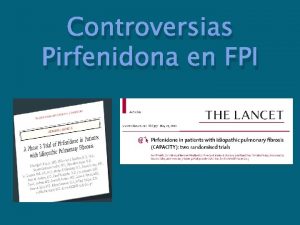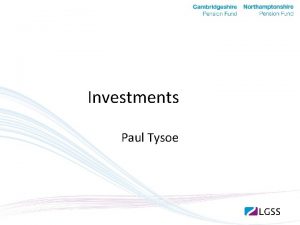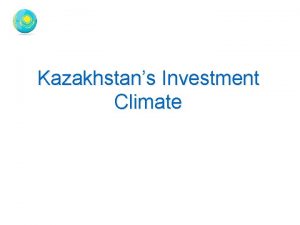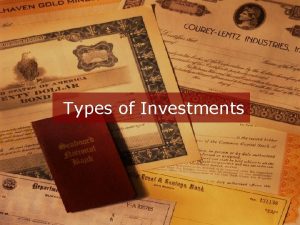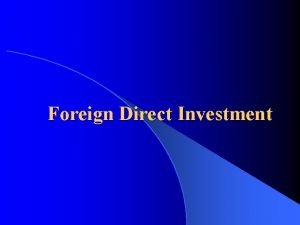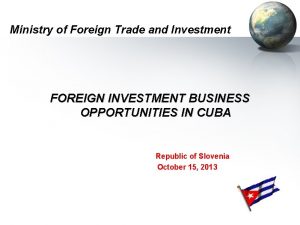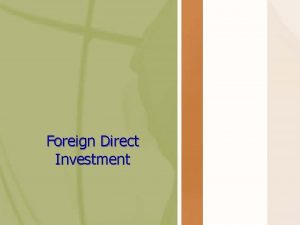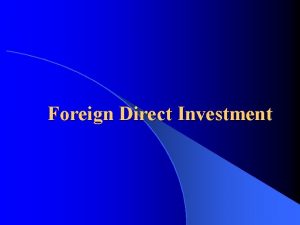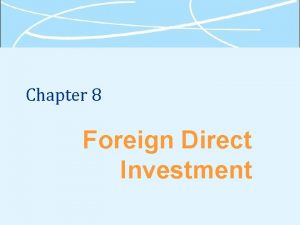Foreign Investments Types of Investment FDI n FPI
























- Slides: 24

Foreign Investments

Types of Investment FDI n FPI n

Advantages and Disadvantages of FDI n n Advantages Expertise Foreign Exchange Job Creation Increase of Exports/ decrease in Imports Disadvantages n Monopoly n National Sovereignty n Exploitation n Transfer Pricing n Threat to Small business

Foreign Direct Investment n n n The surge in flows of FDI in the last 2 decades had important effects on global value chains of production, on developing countries (DCs), and on attitudes towards such investment. Attitudes towards FDI and experiences with it in DCs affect host economy policies, which in turn affect subsequent experiences. Both FDI policies and experiences, as well as their perceived feedback, influence attitudes toward negotiating a multilateral framework for investment (MFI).

Recent Trends and Effects Very rapid growth in global FDI 1999 -2007. n Especially rapid growth (general opening up) and ( Asian crisis Lat. Am privatizations). n In most years, FDI grew faster than global trade and GDP. n

Index of World Exports, FDI Outflows, and Output, 1990 -2002 (1990=100) Source: Exports & GDP – WEO Database; FDI Outflows – UNCTAD FDI database.

FDI Top 10 in Developing Asia Average Annual Total Inflows, $ billion Rank Host economy 19982000 Rank Host economy 20002002 1 China, People’s Rep of 14. 3 1 China, People’s Rep of 41. 6 2 Malaysia 5. 0 2 Hong Kong, China 33. 8 3 Hong Kong, China 3. 9 3 Korea, Rep. of 8. 0 4 Singapore 3. 9 4 Singapore 7. 9 5 Thailand 2. 0 5 Thailand 3. 8 6 Indonesia 1. 8 6 Malaysia 3. 5 7 Taipei, China 1. 0 7 Taipei, China 2. 7 8 Philippines 0. 9 8 India 2. 4 9 Korea, Rep. of 0. 8 9 Viet Nam 1. 5 10 Kazakhstan 0. 7 10 Kazakhstan 1. 3 Total Asia-Pacific 36. 0 Total Asia-Pacific 108. 5 (% of World Total) 19. 3 (% of World Total) 9. 9

Domestic Policy Changes n n Host country policy framework plays a critical role in determining the effects of FDI on a recipient country. A key argument concerns the nexus between trade and FDI liberalization. Trade reform alters the incentive of production for the domestic market relative to exports, resulting in a fundamental shift in the behaviour of MNEs and in the FDI cost-benefit calculus from ‘rent-seeking’ to ‘efficiency-seeking’ FDI.

FDI Regimes n n Dual policy regimes FDI regimes have become more open but considerable selectivity across sectors and firms. Typically a mix of both ‘rent-seeking’ and ‘efficiency-seeking’ FDI, reflecting partial reform of trade regimes, and the political economy of dispensing patronage, e. g. • FDI policy may differ between regions. • Large inter-industry differences in protection, and thus incentives. • SOEs typically receive preferential treatment, especially in PRC, India and Viet Nam, and their MNE joint venture partners. • Most countries offer fiscal or financial incentives. These vary by sales orientation, the technology introduced by the foreign investor, location of investment, and other factors. • The regulatory regime frequently offers more than one entry option.

The Commercial Environment n n n As economies open up, governments have to make the transition from protectionist/regulatory regimes to an emphasis on promotion and efficiency. The ‘three I’s’: incentives, infrastructure, and institutions. Note too that domestic investors are invariably the key players in any economy.

THE RISE OF THE MULTINATIONAL CORPORATION I. The MNC A. Definition a company with production and distribution facilities in more than one country.

THE RISE OF THE MULTINATIONAL CORPORATION 2. MNC supercedes theory: a. mobility of factors b. different costs/skills between nations c. prime transmitter of competitive forces

THE RISE OF THE MULTINATIONAL CORPORATION C. EVOLUTION OF THE MNC Reasons to Go Global: 1. raw materials 2. more markets 3. minimize costs of production

THE RISE OF THE MULTINATIONAL CORPORATION 1. RAW MATERIAL SEEKERS exploit markets in other countries historically first to appear modern-day counterparts Anaconda Copper Standard Oil

THE RISE OF THE MULTINATIONAL CORPORATION 2. MARKET SEEKERS produce and sell in foreign markets heavy foreign direct investors representative firms: IBM Nestle Levi Strauss

THE RISE OF THE MULTINATIONAL CORPORATION 3. COST MINIMIZERS seek lower-cost production abroad motive: to remain cost competitive representative firms: Texas Instruments Atari Zenith

THE RISE OF THE MULTINATIONAL CORPORATION D. THE MNC: A BEHAVIORAL VIEW 1. State of mind: committed to producing, undertaking investment and marketing, and financing globally.

THE RISE OF THE MULTINATIONAL CORPORATION E. THE GLOBAL MANAGER 1. Understands political and economic differences; 2. Searches for most costeffective suppliers; 3. Evaluates changes on value of the firm.

MNCs I. THE MULTINATIONAL FINANCIAL SYSTEM A. Main Objective of MNC: Maximize shareholder wealth B. Other Objectives Reflect Ability to Link: Via Affiliate transfer mechanisms

C. Mode of Transfer Reflects freedom to select a variety of financial channels. D. Timing Flexibility Most MNC have some flexibility in timing of fund flows.

E. Value The ability to avoid national taxes has led to controversy.

II. FUNCTIONS OF FINANCIAL MANAGEMENT A. Two Basic Functions: 1. Financing 2. Investing

Issues Transfer Pricing Exploitation Creates Monopoly

B. Additional Factors Facing the MNC Executive 1. Political risk 2. Economic risk
 Czerniak nowotwór
Czerniak nowotwór Fpi ukm
Fpi ukm Metilazione del dna
Metilazione del dna Too foreign for here too foreign for home
Too foreign for here too foreign for home Starbucks foreign direct investment
Starbucks foreign direct investment Foreign direct investment advantages and disadvantages
Foreign direct investment advantages and disadvantages Greenfield investment
Greenfield investment Foreign direct investment advantages and disadvantages
Foreign direct investment advantages and disadvantages Foreign investment in finland
Foreign investment in finland Eclectic theory
Eclectic theory Malay damania
Malay damania Afnan hossain
Afnan hossain Fixed investment and inventory investment
Fixed investment and inventory investment Types of specialized investments
Types of specialized investments Chapter 11 investing for the future
Chapter 11 investing for the future Fdi tooth numbering system
Fdi tooth numbering system Vertical fdi examples
Vertical fdi examples Tratado kellog alfaro
Tratado kellog alfaro Fdi meaning
Fdi meaning Fdi meaning
Fdi meaning Foreign capital
Foreign capital Market entry strategy
Market entry strategy Fdi
Fdi Fdi in international business
Fdi in international business Fdi tutor2u
Fdi tutor2u




